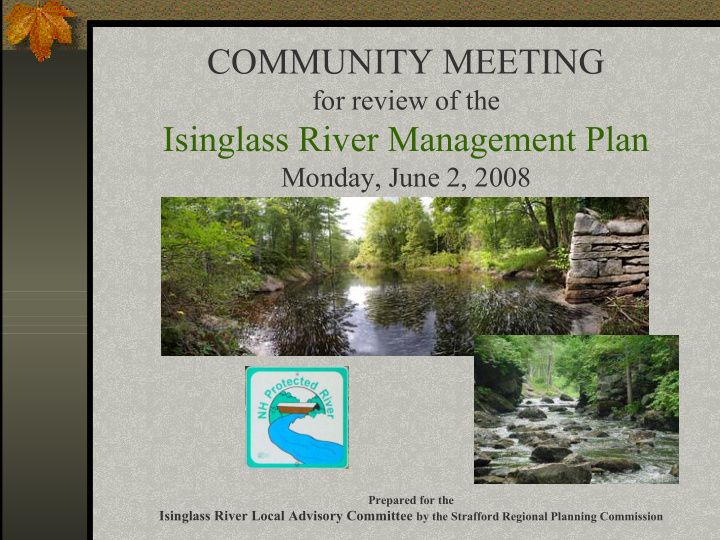



COMMUNITY MEETING for review of the Isinglass River Management Plan Monday, June 2, 2008 Prepared for the Isinglass River Local Advisory Committee by the Strafford Regional Planning Commission
This project was funded by a grant from the New Hampshire Department of Environmental Services.
The Isinglass River Local Advisory Committee Wayne Donle – Strafford Chair - Elizabeth Evans - Strafford Maryalice Fischer – Strafford Bruce Smith – Strafford emeritus Ann Schulz – Barrington Pam Skeffington – Barrington Ted Walsh - Barrington John Johnstone – Rochester Elaine Lauterborn - Rochester Alan Davis – Rochester Dean Peschel – City of Dover
NH Designated Rivers New Hampshire Rivers Management and Protection Program Isinglass River is 1 of 15 Designated Rivers in the state
NH Designated Rivers Isinglass River - Designated Status � Provides increased protection against the construction of new dams, channel alterations, water quality impairment, and siting of solid and hazardous waste facilities in the river corridor � Establishment of a local river management advisory committee to coordinate management and protection of the river at the local and regional levels � Development of a long-range management plan for the river
Designated Segments Segment Location Segment Length Designation (linear miles) Rural River In the Town of Stafford from the outflow of 0.54 Bow Lake Dam to immediately downstream of the Route 202A bridge Natural River From immediately downstream of the Route 5.75 202A bridge in the Town of Strafford to immediately upstream of the Route 126 bridge in the Town of Barrington Rural River From immediately upstream of the Route 11.64 126 bridge in the Town of Barrington, to the confluence with the Cocheco River in the City of Rochester Total Miles 17.93
River Corridor and Watershed
Watershed Communities Community Watershed (acres) Watershed (%) Barrington 13,638 26.5 Dover 13 0.03 Farmington 3,825 7.6 New Durham 0.5 <0.01 Northwood 3,252 6.4 Rochester 7,079 13.8 Strafford 23,487 45.8 Total 51,399
Significant Resources The Land Conservation Plan for New Hampshire’s Coastal Watersheds Resource Corridor Watershed Core Focus Areas and 2,890 26,122 Supporting Landscape NH Wildlife Action Plan Resource Corridor Watershed Exemplary Natural Communities 5,395 48,098 Resource Corridor Watershed Forest Cover 3,449 38,043 Wetlands 510 4,006
River Flows USGS Gage Station #010728700 Isinglass River, Strafford County, NH Drainage Area 73.6 square miles Year Annual Ave. Discharge (cfs) Annual Peak Discharge (cfs) 2003 Not reported 862 2004 140 1,740 2005 158 1,780 2006 239 4,370 Part of a 2-year multipurpose stream flow monitoring network expansion project for 15 new stream gages across New Hampshire The expansion project was requested by the New Hampshire Rivers Management Advisory Committee (RMAC), proposed by the Stream Gage Task Force (SGTF), and funding for installation was provided by the New Hampshire Legislature. The USGS station operated is cooperation with the New Hampshire Department of Environmental Services.
Overview Management approach focused on � Protecting and conserving the rivers many resources � Protecting riparian and aquatic habitat � Advocating for water quality and quantity to sustain aquatic and recreational uses � Balancing the development of land and water uses for recreation with other public needs within the river corridor and watershed
Primary Goals Isinglass River LAC supports Implementation of the Plan Supports integration of its goals and strategies by the corridor communities in their planning initiatives and land use decisions Establish a unified framework for river corridor and watershed communities Work together to achieve protection of the Isinglass River and its resources
Purpose The purpose of the River Management Plan is to � Identify exiting resources and current conditions � Identify priority management issues � Prioritize management issues and develop strategies � Develop and implement an action plan to achieve the management priorities
Primary Issues Water Quality and Quantity Flood Management and Remediation Land Protection Resource and Habitat Conservation River Corridor and Watershed Planning Stewardship, Education and Outreach
Primary Issue Water Quality and Quantity Maintain viability of fishery Maintain high water quality Protect and restore riparian areas and buffers Protect public and private drinking water sources Raise awareness of nonpoint source pollution Maintain Class B status for recreational uses Balance uses while reserving the river quality
Primary Issue Flood Management and Remediation Preserve flood storage areas Reduce and prevent flood damage to river/riparian areas Improve habitat protection at river/tributary crossings Improve road management post-flood cleanup practices Improve stormwater management methods
Primary Issue Land Protection- Resource and Habitat Conservation Prioritize lands for protection and conservation Implement instream flows for habitat and recreation Preserve forests, open space and habitat Conserve riparian, shoreland and water quality buffers Preserve historic resources in the river corridor
Primary Issue River Corridor and Watershed Planning Coordinate watershed planning with partner agencies and organizations Coordinate watershed planning among the communities Consistency in levels of resource protection Sharing of information and resources
Primary Issue Stewardship, Education and Outreach Raise Awareness of the river and its resources Foster stewardship of riparian landowners and all residents in the watershed Pursue education and outreach across various media Promote education about natural communities in the river and watershed
Public Comment Have local concerns not been addressed? How can coordination within the watershed be improved? How might your community use this plan?
Recommend
More recommend